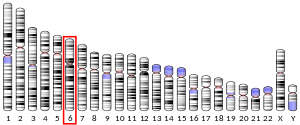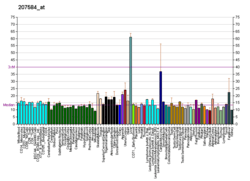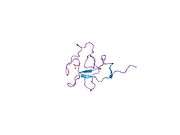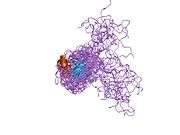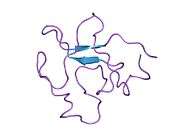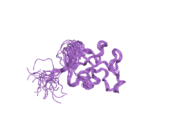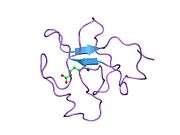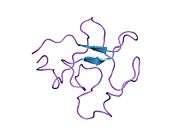Lipoprotein(a)
| LPA | |||||||||||||||||||||||||
|---|---|---|---|---|---|---|---|---|---|---|---|---|---|---|---|---|---|---|---|---|---|---|---|---|---|
 | |||||||||||||||||||||||||
| Identifiers | |||||||||||||||||||||||||
| Aliases | LPA, AK38, APOA, LP, Lipoprotein(a) | ||||||||||||||||||||||||
| External IDs | HomoloGene: 87856 GeneCards: LPA | ||||||||||||||||||||||||
| |||||||||||||||||||||||||
| |||||||||||||||||||||||||
| Orthologs | |||||||||||||||||||||||||
| Species | Human | Mouse | |||||||||||||||||||||||
| Entrez |
| ||||||||||||||||||||||||
| Ensembl |
| ||||||||||||||||||||||||
| UniProt |
|
| |||||||||||||||||||||||
| RefSeq (mRNA) |
| ||||||||||||||||||||||||
| RefSeq (protein) |
|
| |||||||||||||||||||||||
| Location (UCSC) | Chr 6: 160.53 – 160.66 Mb | n/a | |||||||||||||||||||||||
| PubMed search | [2] | n/a | |||||||||||||||||||||||
| Wikidata | |||||||||||||||||||||||||
| |||||||||||||||||||||||||
Lipoprotein(a) (also called Lp(a) or LPA) is a lipoprotein subclass. Genetic studies and numerous epidemiologic studies have identified Lp(a) as a risk factor for atherosclerotic diseases such as coronary heart disease and stroke.[3][4][5][6][7]
Lipoprotein(a) was discovered in 1963 by Kåre Berg[8] and the human gene encoding apolipoprotein(a) was cloned in 1987.[9]
Structure
Lipoprotein(a) [Lp(a)] consists of an LDL-like particle and the specific apolipoprotein(a) [apo(a)], which is covalently bound to the apoB of the LDL like particle. Lp(a) plasma concentrations are highly heritable and mainly controlled by the apolipoprotein(a) gene [LPA] located on chromosome 6q26-27. Apo(a) proteins vary in size due to a size polymorphism [KIV-2 VNTR], which is caused by a variable number of so-called kringle IV repeats in the LPA gene. This size variation at the gene level is expressed on the protein level as well, resulting in apo(a) proteins with 10 to > 50 kringle IV repeats (each of the variable kringle IV consists of 114 amino acids).[9][10] These variable apo(a) sizes are known as "apo(a) isoforms". There is a general inverse correlation between the size of the apo(a) isoform and the Lp(a) plasma concentration[11] One theory for the size/plasma level correlation involves difference rates of protein synthesis. There appears to be a relationship between the number of kringle repeats and the processing time of the precursor apo (a) protein. That is, the larger the isoform, the more apo(a) precursor protein accumulates intracellularly in the endoplasmic reticulum. Lipoprotein (a) is not fully synthesized until the precursor protein is released from the cell, so the slower rate of production for the larger isoforms limits the plasma concentration.[12][13]
Apo(a) is expressed by liver cells (hepatocytes), and the assembly of apo(a) and LDL particles seems to take place at the outer hepatocyte surface. The half-life of Lp(a) in the circulation is about 3 to 4 days.[14]
Catabolism and clearance
The mechanism and sites of Lp(a) catabolism are largely unknown. Uptake via the LDL receptor is not a major pathway of Lp(a) metabolism.[15][16] The kidney has been identified as playing a role in Lp(a) clearance from plasma.[17]
Populations
Lp(a) concentrations vary over one thousandfold between individuals, from <0.2 to > 200 mg/dL. This range of concentrations is observed in all populations studied so far. The mean and median concentrations between different world populations show distinct particularities, the main being the two- to threefold higher Lp(a) plasma concentration of populations of African descent compared to Asian, Oceanic, or European populations. The general inverse correlation between apo(a) isoform size and Lp(a) plasma concentration is observed in all populations. However, mean Lp(a) associated with certain apo(a) isoforms varies between populations.
Function
Lp(a) is assembled at the hepatocyte cell membrane surface, while other scenarios exist with regard to the location of assembly.[18][19][20] It mainly exists in plasma. Lp(a) contributes to the process of atherogenesis. Because of its structural similarity to plasminogen and tissue plasminogen activator, competitive inhibition leads to reduced fibrinolysis, and as a result of the stimulation of secretion of plasminogen activator inhibitor 1, Lp(a) leads to thrombogenesis.[21][22][23] It may also enhance coagulation by inhibiting the function of tissue factor pathway inhibitor.[24] Lp(a) carries cholesterol and binds atherogenic proinflammatory oxidized phospholipids as a preferential carrier of oxidized phospholipids in human plasma,[25] which attract inflammatory cells to vessel walls and leads to smooth muscle cell proliferation.[26] Moreover, Lp(a) is also hypothesized to be involved in wound healing and tissue repair, interacting with components of the vascular wall and extra cellular matrix.[27][28][29] Apo(a), a distinct feature of the Lp(a) particle, binds to immobilized fibronectin and endows Lp(a) with the serine-proteinase-type proteolytic activity.[30]
However, individuals without Lp(a) or with very low Lp(a) levels seem to be healthy.[31] Thus, plasma Lp(a) is not vital, at least under normal environmental conditions. Since apo(a)/Lp(a) derived rather recently in mammalian evolution - only old world monkeys and humans have been shown to harbour Lp(a) - its function might not be vital but just evolutionarily advantageous under certain environmental conditions, e.g. in case of exposure to certain infectious diseases.
Another possibility, suggested by Linus Pauling, is that Lp(a) is a primate adaptation to L-gulonolactone oxidase (GULO) deficiency, found only in certain lines of mammals. GULO is required for converting glucose to ascorbic acid (vitamin C), which is needed to repair arteries; following the loss of GULO, those primates that adopted diets less abundant in vitamin C may have used Lp(a) as an ascorbic-acid surrogate to repair arterial walls.[32]
Pathology
The structure of lipoprotein (a) is similar to plasminogen and tPA (tissue plasminogen activator) and it competes with plasminogen for its binding site, leading to reduced fibrinolysis. Also, because Lp(a) stimulates secretion of PAI-1, it leads to thrombogenesis. Lp(a) also carries cholesterol and thus contributes to atherosclerosis.[7][33] In addition, Lp(a) transports the more atherogenic proinflammatory oxidized phospholipids, which attract inflammatory cells to vessel walls,[34][35] and leads to smooth muscle cell proliferation.[36]
Lipoprotein(a) and disease
High Lp(a) in blood is a risk factor for coronary heart disease (CHD), cardiovascular disease (CVD), atherosclerosis, thrombosis, and stroke.[37] The association between Lp(a) levels and stroke is not as strong as that between Lp(a) and cardiovascular disease.[3] Lp-a concentrations may be affected by disease states (for example kidney failure), but are only slightly affected by diet, exercise, and other environmental factors. Most commonly prescribed lipid-reducing drugs have little or no effect on Lp(a) concentration. Results using statin medications have been mixed in most trials, although a meta-analysis published in 2012 suggests that atorvastatin may be of benefit.[38] Niacin (Vitamin B3) have shown to reduce the levels of Lp(a) in individuals with high levels of low-molecular weight lipoprotien(a).[39]
High Lp(a) predicts risk of early atherosclerosis INDEPENDENTLY of other cardiac risk factors, including LDL. In patients with advanced cardiovascular disease, Lp(a) indicates a coagulant risk of plaque thrombosis. Apo(a) contains domains that are very similar to plasminogen (PLG). Lp(a) accumulates in the vessel wall and inhibits binding of PLG to the cell surface, reducing plasmin generation, which increases clotting. This inhibition of PLG by Lp(a) also promotes proliferation of smooth muscle cells. These unique features of Lp(a) suggest Lp(a) causes generation of clots and atherosclerosis.[40]
Vegetarians have higher levels of Lp-a than fish eaters in one homogeneous tribal population of Tanzania raising the possibility that pharmacologic amounts of fish oil supplements may be helpful to lower the levels of Lp-a.[41]
Some studies have shown that regular consumption of moderate amounts of alcohol leads to significant decline in plasma levels of Lp-a while other studies have not.[42]
Diagnostic testing
Numerous studies confirming a strong correlation between elevated Lp(a) and heart disease have led to the consensus that Lp(a) is an important, independent predictor of cardiovascular disease.[3] Animal studies have shown that Lp(a) may directly contribute to atherosclerotic damage by increasing plaque size, inflammation, instability, and smooth muscle cell growth.[43] Genetic data also support the theory that Lp(a) causes cardiovascular disease.[4]
The European Atherosclerosis Society currently recommends that patients with a moderate or high risk of cardiovascular disease have their lipoprotein (a) levels checked. Any patient with one of the following risk factors should be screened;
- premature cardiovascular disease
- familial hypercholesterolaemia
- family history of premature cardiovascular disease
- family history of elevated lipoprotein (a)
- recurrent cardiovascular disease despite statin treatment
- ≥3% 10-year risk of fatal cardiovascular disease according to the European guidelines
- ≥10% 10-year risk of fatal and/or non-fatal cardiovascular disease according to the US guidelines[3]
If the level is elevated, treatment should be initiated with a goal of bringing the level below 50 mg/dL. In addition, the patient's other cardiovascular risk factors (including LDL levels) should be optimally managed.[3] Apart from the total Lp(a) plasma concentration, the apo(a) isoform might be an important risk parameter as well.[44][45]
Prior studies of the relationship between LP(a) and ethnicity have shown inconsistent results. Lipoprotein (a) levels seem to differ in different populations. For example, in some African populatation, Lp(a) levels are, on average higher, than other groups, so that using a risk threshold of 30 mg/dl would classify up to > 50% of the individuals as higher risk.[46][47][48][49] Some part of this complexity may be related to the different genetic factors involved in determining Lp(a) levels. One recent study showed that in different ethnic groups, different genetic alterations were associated with increased Lp(a) levels.[50]
More recent data suggest that prior studies were under-powered. The Atherosclerosis Risk in Communities (ARIC) followed 3467 African Americans and 9851 whites for 20 years. The researchers found that an elevated Lp(a) conferred the same risk in each group. However, African Americans had roughly three times the level of Lp(a), and Lp(a) also predicted an increased risk of stroke.[51]
Approximate levels of risk are indicated by the results below, although at present there are a variety of different methods by which to measure Lp(a). A standardized international reference material has been developed and is accepted by the WHO Expert Committee on Biological Standardization and the International Federation of Clinical Chemistry and Laboratory Medicine. Although further standardization is still needed, development of a reference material is an importance step towards standardizing results.[52][53]
Lipoprotein(a) - Lp(a)[54]
- Desirable: < 14 mg/dL (< 35 nmol/L)
- Borderline risk: 14 - 30 mg/dL (35 - 75 nmol/L)
- High risk: 31 - 50 mg/dL (75 - 125 nmol/L)
- Very high risk: > 50 mg/dL (> 125 nmol/L)
LP(a) appears with different isoforms (per kringle repeats) of apolipoprotein - 40% of the variation in Lp(a) levels when measured in mg/dl can be attributed to different isoforms. Lighter Lp(a) are also associated with disease. Thus a test with simple quantitative results may not provide a complete assessment of risk.[55]
Treatment
At the current time, the simplest treatment for an elevated lipoprotein(a) is niacin, 1-3 grams daily, in general in an extended-release form. Niacin therapy can reduce lipoprotein(a) levels by 20-30%.[56] A more effectve treatment is the Linus Pauling protocol: 6-18 grams/day ascorbic acid, 6 grams/day L-lysine and 2 grams/day L-proline. This protocol can reduce LP(a) 2-5 fold over a few months. Aspirin may be beneficial, as well, but has only been tested in patients that carry the apolipoprotein(a) gene minor allele variant (rs3798220).[57] A recent meta-analysis suggests that atorvastatin may also lower Lp(a) levels.[38] In severe cases, such as familial hypercholesterolemia, or treatment resistant hypercholesterolemia, lipid apheresis may result in dramatic reductions of lipoprotein(a). The goal of treatment is to reduce levels to below 50 mg/dL.[3]
Other medications that are in various stages of development include thyromimetics, cholesterol-ester-transfer protein (CETP inhibitors), anti-sense oligonucleopeptides, and proprotein convertase subtilisin/kexin type 9 (PCSK-9) inhibitors. L-carnitine may also reduce lipoprotein a levels. TRT (testosterone replacement therapy) also causes Lp(a) to drop.[58]
Gingko biloba may be beneficial, but has not been clinically verified.[59] Coenzyme Q-10 and pine bark extract have been suggested as beneficial, but neither has been proven in clinical trials.[60][61]
Testosterone is known to reduce lipoprotein(a) levels.[62] Testosterone replacement therapy also appears to be associated with lower lipoprotein(a) levels.[63] One large study suggested that there was a decreased association between lipoprotein(a) levels and risk. Estrogen as a prevention strategy for heart disease is current topic of much research and debate. Risks and benefits may need to be considered for each individual. At present, estrogen is not indicated for treatment of elevated lipoprotein(a).[64] Tamoxifen and raloxifene have not been shown to reduce levels.
The American Academy of Pediatrics now recommends that all children be screened for cholesterol between the ages of 9 and 11. Lipoprotein(a) levels should be considered in particular in children with a family history of early heart disease or high blood cholesterol levels. Unfortunately, there have not been enough studies to determine which therapies might be beneficial.[65]
Interactions
Lipoprotein(a) has been shown to interact with Calnexin,[66][67] Fibronectin[30] and Fibrinogen beta chain.[68]
See also
- Lipoprotein
- Apolipoprotein
- Very-low-density lipoprotein
- Low-density lipoprotein
- Combined hyperlipidemia
References
- 1 2 3 GRCh38: Ensembl release 89: ENSG00000198670 - Ensembl, May 2017
- ↑ "Human PubMed Reference:".
- 1 2 3 4 5 6 Nordestgaard BG, Chapman MJ, Ray K, Borén J, Andreotti F, Watts GF, Ginsberg H, Amarenco P, Catapano A, Descamps OS, Fisher E, Kovanen PT, Kuivenhoven JA, Lesnik P, Masana L, Reiner Z, Taskinen MR, Tokgözoglu L, Tybjærg-Hansen A (December 2010). "Lipoprotein(a) as a cardiovascular risk factor: current status". Eur. Heart J. 31 (23): 2844–53. PMC 3295201
 . PMID 20965889. doi:10.1093/eurheartj/ehq386.
. PMID 20965889. doi:10.1093/eurheartj/ehq386. - 1 2 Kamstrup PR, Tybjærg-Hansen A, Nordestgaard BG (April 2011). "Lipoprotein(a) and risk of myocardial infarction--genetic epidemiologic evidence of causality". Scand. J. Clin. Lab. Invest. 71 (2): 87–93. PMID 21231777. doi:10.3109/00365513.2010.550311.
- ↑ Danesh J, Collins R, Peto R (2000). "Lipoprotein(a) and coronary heart disease. Meta-analysis of prospective studies". Circulation. 102 (10): 1082–5. PMID 10973834. doi:10.1161/01.CIR.102.10.1082.
- ↑ Smolders B, Lemmens R, Thijs V (2007). "Lipoprotein (a) and stroke: a meta-analysis of observational studies". Stroke. 38 (6): 1959–66. PMID 17478739. doi:10.1161/STROKEAHA.106.480657.
- 1 2 Schreiner PJ, Morrisett JD, Sharrett AR, Patsch W, Tyroler HA, Wu K, Heiss G (1993). "Lipoprotein[a] as a risk factor for preclinical atherosclerosis" (PDF). Arterioscler. Thromb. 13 (6): 826–33. PMID 8499402. doi:10.1161/01.ATV.13.6.826.
- ↑ Berg K (1963). "A NEW SERUM TYPE SYSTEM IN MAN--THE LP SYSTEM". Acta Pathol Microbiol Scand. 59 (3): 369–82. PMID 14064818. doi:10.1111/j.1699-0463.1963.tb01808.x.
- 1 2 McLean JW, Tomlinson JE, Kuang WJ, Eaton DL, Chen EY, Fless GM, Scanu AM, Lawn RM (1987). "cDNA sequence of human apolipoprotein(a) is homologous to plasminogen". Nature. 330 (6144): 132–7. PMID 3670400. doi:10.1038/330132a0.
- ↑ Utermann G, Menzel HJ, Kraft HG, Duba HC, Kemmler HG, Seitz C (August 1987). "Lp(a) glycoprotein phenotypes. Inheritance and relation to Lp(a)-lipoprotein concentrations in plasma". J. Clin. Invest. 80 (2): 458–65. PMC 442258
 . PMID 2956279. doi:10.1172/JCI113093.
. PMID 2956279. doi:10.1172/JCI113093. - ↑ Sandholzer C, Hallman DM, Saha N, Sigurdsson G, Lackner C, Császár A, Boerwinkle E, Utermann G (1991). "Effects of the apolipoprotein(a) size polymorphism on the lipoprotein(a) concentration in 7 ethnic groups". Hum. Genet. 86 (6): 607–14. PMID 2026424. doi:10.1007/BF00201550.
- ↑ Lobentanz EM, Krasznai K, Gruber A, Brunner C, Müller HJ, Sattler J, Kraft HG, Utermann G, Dieplinger H (April 1998). "Intracellular metabolism of human apolipoprotein(a) in stably transfected Hep G2 cells". Biochemistry. 37 (16): 5417–25. PMID 9548923. doi:10.1021/bi972761t.
- ↑ Brunner C, Lobentanz EM, Pethö-Schramm A, Ernst A, Kang C, Dieplinger H, Müller HJ, Utermann G (1996). "The number of identical kringle IV repeats in apolipoprotein(a) affects its processing and secretion by HepG2 cells". J. Biol. Chem. 271 (50): 32403–10. PMID 8943305. doi:10.1074/jbc.271.50.32403.
- ↑ Rader DJ, Cain W, Zech LA, Usher D, Brewer HB (February 1993). "Variation in lipoprotein(a) concentrations among individuals with the same apolipoprotein (a) isoform is determined by the rate of lipoprotein(a) production". J. Clin. Invest. 91 (2): 443–7. PMC 287951
 . PMID 8432853. doi:10.1172/JCI116221.
. PMID 8432853. doi:10.1172/JCI116221. - ↑ Knight BL, Perombelon YF, Soutar AK, Wade DP, Seed M (1991). "Catabolism of lipoprotein(a) in familial hypercholesterolaemic subjects". Atherosclerosis. 87 (2-3): 227–37. PMID 1830206. doi:10.1016/0021-9150(91)90025-X.
- ↑ Rader DJ, Mann WA, Cain W, Kraft HG, Usher D, Zech LA, Hoeg JM, Davignon J, Lupien P, Grossman M (March 1995). "The low density lipoprotein receptor is not required for normal catabolism of Lp(a) in humans". J. Clin. Invest. 95 (3): 1403–8. PMC 441483
 . PMID 7883987. doi:10.1172/JCI117794.
. PMID 7883987. doi:10.1172/JCI117794. - ↑ Albers JJ, Koschinsky ML, Marcovina SM (2007). "Evidence mounts for a role of the kidney in lipoprotein(a) catabolism". Kidney Int. 71 (10): 961–2. PMID 17495935. doi:10.1038/sj.ki.5002240.
- ↑ White AL, Lanford RE (November 1994). "Cell surface assembly of lipoprotein(a) in primary cultures of baboon hepatocytes". The Journal of Biological Chemistry. 269 (46): 28716–23. PMID 7961823.
- ↑ Dieplinger H, Utermann G (June 1999). "The seventh myth of lipoprotein(a): where and how is it assembled?". Current Opinion in Lipidology. 10 (3): 275–83. PMID 10431664. doi:10.1097/00041433-199906000-00010.
- ↑ Koschinsky ML, Marcovina SM (April 2004). "Structure-function relationships in apolipoprotein(a): insights into lipoprotein(a) assembly and pathogenicity". Current Opinion in Lipidology. 15 (2): 167–74. PMID 15017359. doi:10.1097/00041433-200404000-00009.
- ↑ Banach M, Aronow WS, Serban C, Sahabkar A, Rysz J, Voroneanu L, Covic A (2015). "Lipids, blood pressure and kidney update 2014". Pharmacological Research. 95-96: 111–25. PMID 25819754. doi:10.1016/j.phrs.2015.03.009.
- ↑ Nordestgaard BG, Chapman MJ, Ray K, Borén J, Andreotti F, Watts GF, Ginsberg H, Amarenco P, Catapano A, Descamps OS, Fisher E, Kovanen PT, Kuivenhoven JA, Lesnik P, Masana L, Reiner Z, Taskinen MR, Tokgözoglu L, Tybjærg-Hansen A (December 2010). "Lipoprotein(a) as a cardiovascular risk factor: current status". European Heart Journal. 31 (23): 2844–53. PMC 3295201
 . PMID 20965889. doi:10.1093/eurheartj/ehq386.
. PMID 20965889. doi:10.1093/eurheartj/ehq386. - ↑ Romagnuolo R, Scipione CA, Boffa MB, Marcovina SM, Seidah NG, Koschinsky ML (May 2015). "Lipoprotein(a) catabolism is regulated by proprotein convertase subtilisin/kexin type 9 through the low density lipoprotein receptor". The Journal of Biological Chemistry. 290 (18): 11649–62. PMC 4416867
 . PMID 25778403. doi:10.1074/jbc.M114.611988.
. PMID 25778403. doi:10.1074/jbc.M114.611988. - ↑ Pan S, Kleppe LS, Witt TA, Mueske CS, Simari RD (September 2004). "The effect of vascular smooth muscle cell-targeted expression of tissue factor pathway inhibitor in a murine model of arterial thrombosis". Thrombosis and Haemostasis. 92 (3): 495–502. PMID 15351845. doi:10.1160/TH04-01-0006.
- ↑ Tsimikas S, Brilakis ES, Miller ER, McConnell JP, Lennon RJ, Kornman KS, Witztum JL, Berger PB (July 2005). "Oxidized phospholipids, Lp(a) lipoprotein, and coronary artery disease". The New England Journal of Medicine. 353 (1): 46–57. PMID 16000355. doi:10.1056/NEJMoa043175.
- ↑ Banach M (April 2016). "Lipoprotein (a)-We Know So Much Yet Still Have Much to Learn …". Journal of the American Heart Association. 5 (4): e003597. PMC 4859302
 . PMID 27108250. doi:10.1161/JAHA.116.003597.
. PMID 27108250. doi:10.1161/JAHA.116.003597. - ↑ Brown MS, Goldstein JL (1987). "Plasma lipoproteins: teaching old dogmas new tricks". Nature. 330 (6144): 113–4. PMID 3670399. doi:10.1038/330113a0.
- ↑ Kostner GM, Bihari-Varga M (August 1990). "Is the atherogenicity of Lp(a) caused by its reactivity with proteoglycans?". European Heart Journal. 11 Suppl E: 184–9. PMID 2146124. doi:10.1093/eurheartj/11.suppl_e.184.
- ↑ van der Hoek YY, Sangrar W, Côté GP, Kastelein JJ, Koschinsky ML (November 1994). "Binding of recombinant apolipoprotein(a) to extracellular matrix proteins". Arteriosclerosis and Thrombosis. 14 (11): 1792–8. PMID 7947605. doi:10.1161/01.atv.14.11.1792.
- 1 2 Salonen EM, Jauhiainen M, Zardi L, Vaheri A, Ehnholm C (December 1989). "Lipoprotein(a) binds to fibronectin and has serine proteinase activity capable of cleaving it". The EMBO Journal. 8 (13): 4035–40. PMC 401578
 . PMID 2531657.
. PMID 2531657. - ↑ Pati N, Rouf A, Pati U (February 2000). "Simultaneous mutations (A/G(-418) and C/T(-384)) in the apo(a) promoter of individuals with low Lp(a) levels". Molecular Genetics and Metabolism. 69 (2): 165–7. PMID 10720444. doi:10.1006/mgme.1999.2956.
- ↑ Pauling L, Rath M (1992). "A Unified Theory of Human Cardiovascular Disease" (PDF). Journal of Orthomolecular Medicine. 7 (1).
- ↑ Sotiriou SN, Orlova VV, Al-Fakhri N, Ihanus E, Economopoulou M, Isermann B, Bdeir K, Nawroth PP, Preissner KT, Gahmberg CG, Koschinsky ML, Chavakis T (2006). "Lipoprotein(a) in atherosclerotic plaques recruits inflammatory cells through interaction with Mac-1 integrin". FASEB J. 20 (3): 559–61. PMID 16403785. doi:10.1096/fj.05-4857fje.
- ↑ Gouni-Berthold I, Berthold HK (November 2011). "Lipoprotein(a): current perspectives". Curr Vasc Pharmacol. 9 (6): 682–92. PMID 21529331. doi:10.2174/157016111797484071.
- ↑ Tsimikas S, Witztum JL (August 2008). "The role of oxidized phospholipids in mediating lipoprotein(a) atherogenicity". Curr. Opin. Lipidol. 19 (4): 369–77. PMID 18607184. doi:10.1097/MOL.0b013e328308b622.
- ↑ Ichikawa T, Unoki H, Sun H, Shimoyamada H, Marcovina S, Shikama H, Watanabe T, Fan J (January 2002). "Lipoprotein(a) promotes smooth muscle cell proliferation and dedifferentiation in atherosclerotic lesions of human apo(a) transgenic rabbits". Am. J. Pathol. 160 (1): 227–36. PMC 1867144
 . PMID 11786416. doi:10.1016/S0002-9440(10)64366-0.
. PMID 11786416. doi:10.1016/S0002-9440(10)64366-0. - ↑ Christian Wilde (2003). Hidden Causes of Heart Attack and Stroke: Inflammation, Cardiology's New Frontier. Abigon Press. pp. 182–183. ISBN 0-9724959-0-8.
- 1 2 Takagi H, Umemoto T (January 2012). "Atorvastatin decreases lipoprotein(a): a meta-analysis of randomized trials". Int. J. Cardiol. 154 (2): 183–6. PMID 21996415. doi:10.1016/j.ijcard.2011.09.060.
- ↑ Sahebkar A, Reiner Ž, Simental-Mendía LE, Ferretti G, Cicero AF (2016). "Effect of extended-release niacin on plasma lipoprotein(a) levels: A systematic review and meta-analysis of randomized placebo-controlled trials". Metabolism: Clinical and Experimental. 65 (11): 1664–1678. PMID 27733255. doi:10.1016/j.metabol.2016.08.007.
- ↑ Caplice NM, Panetta C, Peterson TE, Kleppe LS, Mueske CS, Kostner GM, Broze GJ, Simari RD (2001). "Lipoprotein (a) binds and inactivates tissue factor pathway inhibitor: a novel link between lipoproteins and thrombosis". Blood. 98 (10): 2980–7. PMID 11698280. doi:10.1182/blood.V98.10.2980.
- ↑ Marcovina SM, Kennedy H, Bittolo Bon G, Cazzolato G, Galli C, Casiglia E, Puato M, Pauletto P (May 1999). "Fish intake, independent of apo(a) size, accounts for lower plasma lipoprotein(a) levels in Bantu fishermen of Tanzania: The Lugalawa Study". Arterioscler. Thromb. Vasc. Biol. 19 (5): 1250–6. PMID 10323776. doi:10.1161/01.ATV.19.5.1250.
- ↑ Sharpe PC, Young IS, Evans AE (May 1998). "Effect of moderate alcohol consumption on lp(a) lipoprotein concentrations. Reduction is supported by other studies". BMJ. 316 (7145): 1675. PMC 1113249
 . PMID 9603764. doi:10.1136/bmj.316.7145.1675.
. PMID 9603764. doi:10.1136/bmj.316.7145.1675. - ↑ Kamstrup PR, Nordestgaard BG (October 2009). "Lipoprotein(a) should be taken much more seriously". Biomark Med. 3 (5): 439–41. PMID 20477514. doi:10.2217/bmm.09.57.
- ↑ Klausen IC, Sjøl A, Hansen PS, Gerdes LU, Møller L, Lemming L, Schroll M, Faergeman O (July 1997). "Apolipoprotein(a) isoforms and coronary heart disease in men: a nested case-control study". Atherosclerosis. 132 (1): 77–84. PMID 9247362. doi:10.1016/S0021-9150(97)00071-3.
- ↑ Paultre F, Pearson TA, Weil HF, Tuck CH, Myerson M, Rubin J, Francis CK, Marx HF, Philbin EF, Reed RG, Berglund L (2000). "High levels of Lp(a) with a small apo(a) isoform are associated with coronary artery disease in African American and white men". Arterioscler. Thromb. Vasc. Biol. 20 (12): 2619–24. PMID 11116062. doi:10.1161/01.ATV.20.12.2619.
- ↑ Helmhold M, Bigge J, Muche R, Mainoo J, Thiery J, Seidel D, Armstrong VW (1991). "Contribution of the apo[a] phenotype to plasma Lp[a] concentrations shows considerable ethnic variation". J. Lipid Res. 32 (12): 1919–28. PMID 1840066.
- ↑ Cobbaert C, Mulder P, Lindemans J, Kesteloot H (1997). "Serum LP(a) levels in African aboriginal Pygmies and Bantus, compared with Caucasian and Asian population samples". J Clin Epidemiol. 50 (9): 1045–53. PMID 9363039. doi:10.1016/S0895-4356(97)00129-7.
- ↑ Schmidt K, Kraft HG, Parson W, Utermann G (2006). "Genetics of the Lp(a)/apo(a) system in an autochthonous Black African population from the Gabon". Eur. J. Hum. Genet. 14 (2): 190–201. PMID 16267501. doi:10.1038/sj.ejhg.5201512.
- ↑ Dahlén GH, Ekstedt B (2001). "The importance of the relation between lipoprotein(a) and lipids for development of atherosclerosis and cardiovascular disease". J. Intern. Med. 250 (3): 265–7. PMID 11555135. doi:10.1046/j.1365-2796.2001.00889.x.
- ↑ Dumitrescu L, Glenn K, Brown-Gentry K, Shephard C, Wong M, Rieder MJ, Smith JD, Nickerson DA, Crawford DC (2011). Kloss-Brandstaetter A, ed. "Variation in LPA is associated with Lp(a) levels in three populations from the Third National Health and Nutrition Examination Survey". PLoS ONE. 6 (1): e16604. PMC 3030597
 . PMID 21305047. doi:10.1371/journal.pone.0016604.
. PMID 21305047. doi:10.1371/journal.pone.0016604. - ↑ Virani SS, Brautbar A, Davis BC, Nambi V, Hoogeveen RC, Sharrett AR, Coresh J, Mosley TH, Morrisett JD, Catellier DJ, Folsom AR, Boerwinkle E, Ballantyne CM (January 2012). "Associations between lipoprotein(a) levels and cardiovascular outcomes in black and white subjects: the Atherosclerosis Risk in Communities (ARIC) Study". Circulation. 125 (2): 241–9. PMID 22128224. doi:10.1161/CIRCULATIONAHA.111.045120.
- ↑ Marcovina SM, Albers JJ, Scanu AM, Kennedy H, Giaculli F, Berg K, Couderc R, Dati F, Rifai N, Sakurabayashi I, Tate JR, Steinmetz A (2000). "Use of a reference material proposed by the International Federation of Clinical Chemistry and Laboratory Medicine to evaluate analytical methods for the determination of plasma lipoprotein(a)". Clin. Chem. 46 (12): 1956–67. PMID 11106328.
- ↑ Dati F, Tate JR, Marcovina SM, Steinmetz A (2004). "First WHO/IFCC International Reference Reagent for Lipoprotein(a) for Immunoassay--Lp(a) SRM 2B". Clin. Chem. Lab. Med. 42 (6): 670–6. PMID 15259385. doi:10.1515/CCLM.2004.114.
- ↑ Ryan, George M; Julius Torelli (2005). Beyond cholesterol: 7 life-saving heart disease tests that your doctor may not give you. New York: St. Martin's Griffin. p. 91. ISBN 0-312-34863-0.
- ↑ Boerwinkle E, Menzel HJ, Kraft HG, Utermann G (April 1989). "Genetics of the quantitative Lp(a) lipoprotein trait. III. Contribution of Lp(a) glycoprotein phenotypes to normal lipid variation". Hum. Genet. 82 (1): 73–8. PMID 2523852. doi:10.1007/BF00288277.
- ↑ Boden WE, Sidhu MS, Toth PP (2014). "The therapeutic role of niacin in dyslipidemia management". J. Cardiovasc. Pharmacol. Ther. 19 (2): 141–58. PMID 24363242. doi:10.1177/1074248413514481.
- ↑ Chasman DI, Shiffman D, Zee RY, Louie JZ, Luke MM, Rowland CM, Catanese JJ, Buring JE, Devlin JJ, Ridker PM (2009). "Polymorphism in the apolipoprotein(a) gene, plasma lipoprotein(a), cardiovascular disease, and low-dose aspirin therapy". Atherosclerosis. 203 (2): 371–6. PMC 2678922
 . PMID 18775538. doi:10.1016/j.atherosclerosis.2008.07.019.
. PMID 18775538. doi:10.1016/j.atherosclerosis.2008.07.019. - ↑ Parhofer KG (2011). "Lipoprotein(a): medical treatment options for an elusive molecule". Curr. Pharm. Des. 17 (9): 871–6. PMID 21476974. doi:10.2174/138161211795428777.
- ↑ Rodríguez M, Ringstad L, Schäfer P, Just S, Hofer HW, Malmsten M, Siegel G (June 2007). "Reduction of atherosclerotic nanoplaque formation and size by Ginkgo biloba (EGb 761) in cardiovascular high-risk patients". Atherosclerosis. 192 (2): 438–44. PMID 17397850. doi:10.1016/j.atherosclerosis.2007.02.021.
- ↑ Lee YJ, Cho WJ, Kim JK, Lee DC (April 2011). "Effects of coenzyme Q10 on arterial stiffness, metabolic parameters, and fatigue in obese subjects: a double-blind randomized controlled study". J Med Food. 14 (4): 386–90. PMID 21370966. doi:10.1089/jmf.2010.1202.
- ↑ Drieling RL, Gardner CD, Ma J, Ahn DK, Stafford RS (September 2010). "No beneficial effects of pine bark extract on cardiovascular disease risk factors". Arch. Intern. Med. 170 (17): 1541–7. PMID 20876405. doi:10.1001/archinternmed.2010.310.
- ↑ Am J Cardiol. 1996 Jun 1;77(14):1244-7
- ↑ Am J Cardiol. 1996 Jun 1;77(14):1244-7
- ↑ Harman SM, Vittinghoff E, Brinton EA, Budoff MJ, Cedars MI, Lobo RA, Merriam GR, Miller VM, Naftolin F, Pal L, Santoro N, Taylor HS, Black DM (March 2011). "Timing and duration of menopausal hormone treatment may affect cardiovascular outcomes". Am. J. Med. 124 (3): 199–205. PMC 3107840
 . PMID 21396500. doi:10.1016/j.amjmed.2010.09.021.
. PMID 21396500. doi:10.1016/j.amjmed.2010.09.021. - ↑ "Expert panel on integrated guidelines for cardiovascular health and risk reduction in children and adolescents: summary report". Pediatrics. 128 Suppl 5: S213–56. December 2011. PMC 4536582
 . PMID 22084329. doi:10.1542/peds.2009-2107C.
. PMID 22084329. doi:10.1542/peds.2009-2107C. - ↑ Bonen DK, Nassir F, Hausman AM, Davidson NO (August 1998). "Inhibition of N-linked glycosylation results in retention of intracellular apo[a] in hepatoma cells, although nonglycosylated and immature forms of apolipoprotein[a] are competent to associate with apolipoprotein B-100 in vitro". J. Lipid Res. 39 (8): 1629–40. PMID 9717723.
- ↑ Nassir F, Xie Y, Davidson NO (April 2003). "Apolipoprotein[a] secretion from hepatoma cells is regulated in a size-dependent manner by alterations in disulfide bond formation". J. Lipid Res. 44 (4): 816–27. PMID 12562843. doi:10.1194/jlr.M200451-JLR200.
- ↑ Klose R, Fresser F, Kochl S, Parson W, Kapetanopoulos A, Fruchart-Najib J, Baier G, Utermann G (December 2000). "Mapping of a minimal apolipoprotein(a) interaction motif conserved in fibrin(ogen) beta - and gamma -chains". J. Biol. Chem. 275 (49): 38206–12. PMID 10980194. doi:10.1074/jbc.M003640200.
Further reading
- Utermann G (1989). "The mysteries of lipoprotein(a)". Science. 246 (4932): 904–10. PMID 2530631. doi:10.1126/science.2530631.
- Salonen EM, Jauhiainen M, Zardi L, Vaheri A, Ehnholm C (1989). "Lipoprotein(a) binds to fibronectin and has serine proteinase activity capable of cleaving it". EMBO J. 8 (13): 4035–40. PMC 401578
 . PMID 2531657.
. PMID 2531657. - Frank SL, Klisak I, Sparkes RS, Mohandas T, Tomlinson JE, McLean JW, Lawn RM, Lusis AJ (1988). "The apolipoprotein(a) gene resides on human chromosome 6q26-27, in close proximity to the homologous gene for plasminogen". Hum. Genet. 79 (4): 352–6. PMID 3410459. doi:10.1007/BF00282175.
- McLean JW, Tomlinson JE, Kuang WJ, Eaton DL, Chen EY, Fless GM, Scanu AM, Lawn RM (1987). "cDNA sequence of human apolipoprotein(a) is homologous to plasminogen". Nature. 330 (6144): 132–7. PMID 3670400. doi:10.1038/330132a0.
- Scanu AM, Pfaffinger D, Lee JC, Hinman J (1994). "A single point mutation (Trp72-->Arg) in human apo(a) kringle 4-37 associated with a lysine binding defect in Lp(a)". Biochim. Biophys. Acta. 1227 (1-2): 41–5. PMID 7918682. doi:10.1016/0925-4439(94)90104-X.
- Grainger DJ, Kemp PR, Liu AC, Lawn RM, Metcalfe JC (1994). "Activation of transforming growth factor-beta is inhibited in transgenic apolipoprotein(a) mice". Nature. 370 (6489): 460–2. PMID 8047165. doi:10.1038/370460a0.
- Mikol V, LoGrasso PV, Boettcher BR (1996). "Crystal structures of apolipoprotein(a) kringle IV37 free and complexed with 6-aminohexanoic acid and with p-aminomethylbenzoic acid: existence of novel and expected binding modes". J. Mol. Biol. 256 (4): 751–61. PMID 8642595. doi:10.1006/jmbi.1996.0122.
- Edelstein C, Italia JA, Klezovitch O, Scanu AM (1996). "Functional and metabolic differences between elastase-generated fragments of human lipoprotein[a] and apolipoprotein[a]". J. Lipid Res. 37 (8): 1786–801. PMID 8864963.
- Edelstein C, Italia JA, Scanu AM (1997). "Polymorphonuclear cells isolated from human peripheral blood cleave lipoprotein(a) and apolipoprotein(a) at multiple interkringle sites via the enzyme elastase. Generation of mini-Lp(a) particles and apo(a) fragments". J. Biol. Chem. 272 (17): 11079–87. PMID 9111002. doi:10.1074/jbc.272.17.11079.
- Köchl S, Fresser F, Lobentanz E, Baier G, Utermann G (1997). "Novel interaction of apolipoprotein(a) with beta-2 glycoprotein I mediated by the kringle IV domain". Blood. 90 (4): 1482–9. PMID 9269765.
- Bonen DK, Nassir F, Hausman AM, Davidson NO (1998). "Inhibition of N-linked glycosylation results in retention of intracellular apo[a] in hepatoma cells, although nonglycosylated and immature forms of apolipoprotein[a] are competent to associate with apolipoprotein B-100 in vitro". J. Lipid Res. 39 (8): 1629–40. PMID 9717723.
- Niemeier A, Willnow T, Dieplinger H, Jacobsen C, Meyer N, Hilpert J, Beisiegel U (1999). "Identification of megalin/gp330 as a receptor for lipoprotein(a) in vitro". Arterioscler. Thromb. Vasc. Biol. 19 (3): 552–61. PMID 10073957. doi:10.1161/01.ATV.19.3.552.
- Edelstein C, Shapiro SD, Klezovitch O, Scanu AM (1999). "Macrophage metalloelastase, MMP-12, cleaves human apolipoprotein(a) in the linker region between kringles IV-4 and IV-5. Potential relevance to lipoprotein(a) biology". J. Biol. Chem. 274 (15): 10019–23. PMID 10187779. doi:10.1074/jbc.274.15.10019.
- Ogorelkova M, Gruber A, Utermann G (1999). "Molecular basis of congenital lp(a) deficiency: a frequent apo(a) 'null' mutation in caucasians". Hum. Mol. Genet. 8 (11): 2087–96. PMID 10484779. doi:10.1093/hmg/8.11.2087.
- Røsby O, Berg K (2000). "LPA gene: interaction between the apolipoprotein(a) size ('kringle IV' repeat) polymorphism and a pentanucleotide repeat polymorphism influences Lp(a) lipoprotein level". J. Intern. Med. 247 (1): 139–52. PMID 10672142. doi:10.1046/j.1365-2796.2000.00628.x.
- Klose R, Fresser F, Kochl S, Parson W, Kapetanopoulos A, Fruchart-Najib J, Baier G, Utermann G (2000). "Mapping of a minimal apolipoprotein(a) interaction motif conserved in fibrin(ogen) beta - and gamma -chains". J. Biol. Chem. 275 (49): 38206–12. PMID 10980194. doi:10.1074/jbc.M003640200.
- Ogorelkova M, Kraft HG, Ehnholm C, Utermann G (2001). "Single nucleotide polymorphisms in exons of the apo(a) kringles IV types 6 to 10 domain affect Lp(a) plasma concentrations and have different patterns in Africans and Caucasians". Hum. Mol. Genet. 10 (8): 815–24. PMID 11285247. doi:10.1093/hmg/10.8.815.
- Garner B, Merry AH, Royle L, Harvey DJ, Rudd PM, Thillet J (2001). "Structural elucidation of the N- and O-glycans of human apolipoprotein(a): role of o-glycans in conferring protease resistance". J. Biol. Chem. 276 (25): 22200–8. PMID 11294842. doi:10.1074/jbc.M102150200.
- Xue S, Madison EL, Miles LA (2001). "The Kringle V-protease domain is a fibrinogen binding region within Apo(a)". Thromb. Haemost. 86 (5): 1229–37. PMID 11816712.
External links
- Lipoprotein(a) at the US National Library of Medicine Medical Subject Headings (MeSH)
